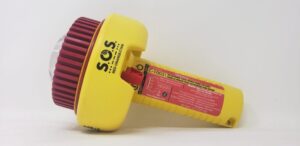2022-Jan-10
Transport Canada Approves the Use of Electronic Visual Distress Signals
 Fantastic news for Georgian Bay boaters! Transport Canada has issued a Tier 1 Policy to accept electronic visual distress signal devices (eVDSD) in lieu of traditional pyrotechnic distress signals (flares) in an effort to improve pleasure craft safety. The policy, which applies only to pleasure craft, came into force on November 9th, 2021 and will be reviewed in five years.
Fantastic news for Georgian Bay boaters! Transport Canada has issued a Tier 1 Policy to accept electronic visual distress signal devices (eVDSD) in lieu of traditional pyrotechnic distress signals (flares) in an effort to improve pleasure craft safety. The policy, which applies only to pleasure craft, came into force on November 9th, 2021 and will be reviewed in five years.
Small Vessel Regulations currently require all pleasure craft longer than six metres to carry pyrotechnic distress signals unless:
- they are operating on a river, canal or lake in which they can at no time be more than one nautical mile from shore; or
- they have no sleeping arrangements and are engaged in an official competition or in final preparation for an official competition
The Burning Issues with Traditional Flares
 Traditional flares are hard to ship, need to be stored in a cool, dry location, and are difficult to dispose of in a safe and environmentally friendly manor. A flare signal only burns for a short time and flares expire about four years after their manufacture date. It’s also hard to find a course to learn how to use them correctly and trying to read the directions during an emergency might add another level of panic.
Traditional flares are hard to ship, need to be stored in a cool, dry location, and are difficult to dispose of in a safe and environmentally friendly manor. A flare signal only burns for a short time and flares expire about four years after their manufacture date. It’s also hard to find a course to learn how to use them correctly and trying to read the directions during an emergency might add another level of panic.
Flares continue to be an option for all nautical emergency kits, but the approval of Electronic Visual Distress Signal Devices (eVDSD) adds an additional choice for distress alerting.
Key Points for the Use of Electronic Visual Distress Signal Devices (eVDSD)
In Canada, pleasure craft can now use eVDSD that are certified to the Radio Technical Commission for Maritime Services (RTCM) standard 13200.0 instead of traditional pyrotechnic distress signals.
Please note:
- This policy only applies to pleasure craft
- A Transport Canada (TC) approved smoke signal be carried with the eVDSD for daytime alerting
- eVDSDs must have documentation from an accredited product certification body, or the United States Coast Guard (USCG), stating that it has been tested to and meets the requirements of the RTCM standard 13200.0.
- Devices must be labelled with the statement, “Complies with RTCM Standard 13200.0 for an eVDSD”. If a device doesn’t include this statement, it is not compliant as an alternative to pyrotechnic distress signals.
 Characteristics of eVDSD
Characteristics of eVDSD
An electronic signal that meets the standard will have:
- signal characteristic in the form of a 2-colour cyan (blue) and red-orange S-O-S light sequence
- near-infrared signal so it can be detected with night vision goggles
- an operating temperature range of -1°C to +30°C
- a storage temperature range of -20°C to +55°C
- an average effective intensity of at least 50 candela
- at least 2 hours continuous operating life
Choosing and Using Electronic Signals
Electronic signals are just one of many ways to signal that you need help. In addition to onboard signaling devices, boaters can use marine VHF, 406MHz Personal Locator Beacons, Emergency Position Indicating Radio Beacons (EPIRB) and other means of two-way communication such as cellular phones to signal for help in an emergency.
Vessel operators should select their distress alerting equipment after assessing:
- your planned route
- the risks associated with that route
- who will help you in an emergency, and where they’re located, and
- the equipment you would need to alert and communicate with those helpers
One of the great things about eVDSDs is how easy they are to learn and use. Like all safety equipment, the eVDSD must be located where it can be accessed immediately and everyone on board should know how to activate it. Everyone should also understand that it’s just one of many ways to signal that you need help.
Maintaining an electronic signal
Each eVDSD comes with an instruction manual from the manufacturer which will include instructions for using, maintaining and caring for your device. Always follow the manufacturer’s instructions and recommendations for how eVDSDs should be maintained and cared for.
Regular inspections and service checks are an important part of keeping all of your equipment ready for use.
Watch this short video to learn more about Transport Canada approved eVDSDs:
